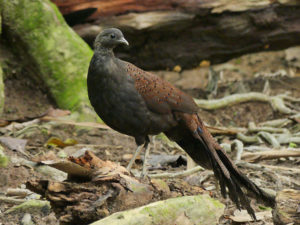Peninsula Malaysia Birding Tour
 6th – 18th September 2024: Peninsula Malaysia birding tour highlights include Garnet Pitta, Malaysian Rail Babbler, Helmeted Hornbill, Mountain Peacock Pheasant, Malayan Laughingthrush, Black Laughingthrush, Rhinoceros Hornbill, Mangrove Blue Flycatcher, Red-naped Trogon, Malayan Banded Pitta, Chestnut-naped Forktail, Green Broadbill, Malaysian Partridge – £3950 per person
6th – 18th September 2024: Peninsula Malaysia birding tour highlights include Garnet Pitta, Malaysian Rail Babbler, Helmeted Hornbill, Mountain Peacock Pheasant, Malayan Laughingthrush, Black Laughingthrush, Rhinoceros Hornbill, Mangrove Blue Flycatcher, Red-naped Trogon, Malayan Banded Pitta, Chestnut-naped Forktail, Green Broadbill, Malaysian Partridge – £3950 per person

Trip Details
- Dates: 6th – 18th September 2024
- Cost: £3950
- Single Supplement: £660
- Deposit: £650
- Tour length: 13 Days (11 days birding)
- Min / Max group size: 5 / 9
- Start/Finish: Kuala Lumpur
- Tour Type: Birding
- Photo Opps: Fair
- Physicality: Moderate
- Tour Leaders: Nick Upton & Lee Kok Chung
Contact us if you have any questions about this trip – info@calidrisbirdingtours.com
Peninsula Malaysia Birding
Standing in the lush rainforest surrounded by towering trees and dense understorey, listening to the sounds of birds and insects one is reminded that there are corners of the earth that remain as they have been for thousands of years. The lowland rainforests host magnificent hornbills, bizarre and colourful broadbills, jewel-like pittas, stunning but often motionless trogons and the bizarre Rail Babbler. The attractive highland areas provide sights and sounds of their own and it is here where flocks of colourful birds feed together as well as some of the region’s most range-restricted species. Added to this are visits to mangroves, rice fields and a variety of forest patches for a diverse picture of Malaysia and its birds. You may have neglected visiting this compact and exciting birding destination; if you want to connect with a large number of Southeast Asia’s most-wanted birds you should neglect it no longer.
Peninsula Malaysia contains the capital city and seat of government of the nation of Malaysia, Kuala Lumpur, separated from Sumatra by the Straits of Malacca, from the island of Borneo by the southern part of the South China Sea and from Singapore by the Johor Strait. This is one of the most developed and well-organized of all Southeast Asian nations making traveling around this small part of the country easy as well as providing pleasant accommodation throughout. This combination allows us to visit a wide variety of habitats and locations in comfort and safety, experiencing a set of birds that will live long in the memory.
For birders who want to see many of the region’s most colourful and impressive birds, this trip is designed to satisfy that urge. This is a great opportunity to enjoy a real festival of colourful birds along with our expert guides adept at finding shy forest species. This is a trip for those who love the thrill of tracking down secretive forest-dwelling birds along with the reward that follows with stunning species such as Red-naped Trogon, Green Broadbill, Rhinoceros Hornbill, Rail Babbler, Garnet Pitta, Blue Nuthatch, Rufous-collared Kingfisher. Persistence and patience is definitely required here but the rewards can include exciting species that include Malayan Whistlingthrush, Mountain Peacock Pheasant, Malaysian Banded Pitta and Helmeted Hornbill. This birding tour to Peninsula Malaysia really should be on your list of things to do for a large number of wonderful birds in a fairly short space of time.
Day 1, Arrival in Kuala Lumpur – 6th September 2024
Today we will arrive at Kuala Lumpur International Airport and transfer to a comfortable hotel so that we are well rested for the next day’s birding. There will be a briefing on the tour before dinner together.
Day 2, Kuala Lumpur – Kuala Selangor – 7th September 2024
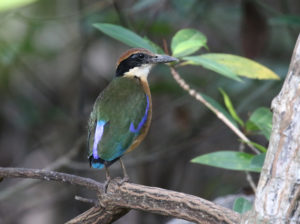
Leaving from our hotel, near Kuala Lumpur International Airport, we will start our journey towards our destination of Kuala Selangor. However, we have the whole day to make a series of birding stops along the way, beginning with a visit to a nearby area of mangroves. Getting to the mangroves involves traveling across open grassland where we expect to see Oriental Pratincoles that breed in this barren habitat along with Paddyfield Pipits. Birding around the edges of the mangroves it should not take long before we hear the call of Mangrove Pitta. These birds can be reluctant to show themselves but at this time of year they should be very active and with patience we expect to get good views of this smart bird. Hopefully we can start this tour, straight off the bat, with a Pitta, one of the most sought-after groups of birds in Asia. Here we should also see Malaysian Pied Fantail, Pacific Swallow and Brahminy Kite soaring overhead.
Moving on we can make a stop at Sungai Buloh which is often a good spot to locate the impressive Lesser Adjutant alongside greater numbers of Painted Storks. The mangrove channels here should provide us with views of Collared Kingfishers while on exposed perches Blue-tailed Bee-eaters should be seen sallying for prey. Birding here should also turn up groups of noisy House Crows and Javan Mynas along with Asian Glossy Starling, Black-crowned Night Heron, Purple Heron and perhaps colourful Common Flameback.
Day 3, Kuala Selangor – Fraser’s Hill – 8th September 2024
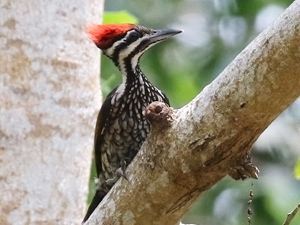
Birding starts immediately after breakfast, which we have shortly before dawn, within the gardens of our hotel. As the sun rises and begins to hit the treetops birds become active with species such as Common Iora and Laced Woodpecker appearing along with Golden-bellied Gerygone. Common Flameback can also be found foraging on dead branches while Pied Triller can be a little trickier to find. As the sun becomes stronger insect life becomes more active and so the birds that feed on them do too. Black-naped Oriole often calls from the tree tops, Indian White-eyes feed in small flocks while Ashy Tailorbird begins to trill before emerging from the undergrowth.
We can also see a lot of common birds here quickly, such as Blue-tailed Bee-eater, Spotted Dove, Coppersmith Barbet, Asian Koel, Malaysian Pied Fantail and Pink-necked Green Pigeon. One of the more scarce species we have a chance of seeing here is Little Bronze Cuckoo; let’s hope we are in luck. Starting here is a nice way to begin the day and it will be interesting to see how many species we can spot in a short space of time, just standing in one spot.
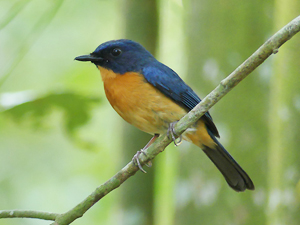
After an hour or so in the garden we will drive a very short distance to Kuala Selangor Nature Park. Here we will walk along the trails through patches of swamp forest and mangrove where we hope to see the increasingly rare Mangrove Blue Flycatcher. We may see a few Common Hill Mynas here in the treetops and Abbott’s Babbler in the undergrowth while the impressive Lesser Adjutant is also a possibility. In the mangroves small parties of birds usually include Cinereous Tit, Golden-bellied Gerygone along with Sunda Pygmy Woodpecker. Here we should also find a habitat specialist in Mangrove Whistler and hopefully Chestnut-bellied Malkoha, another species restricted to the extreme lowlands. As the day warms up we can expect to see some soaring raptors. White-bellied Sea Eagle and Brahminy Kite are both coastal birds that we can expect here and it is also likely that we will spot Crested Serpent Eagle either perched or in flight.
After lunch our journey to Fraser’s Hill begins. After a few hours of driving we will start to make some birding stops as we climb in altitude. We should be able to find wonderful Whiskered Treeswift perched on top of exposed branches while waiting at a small waterfall usually provides us with views of Chestnut-naped Forktail, one of the most stunning of a great group of birds. Further along we will look for other impressive birds that include comedic-looking Black-and-yellow Broadbill and Red-bearded Bee-eater as well as many of the commoner birds that we will see again over the next few days.
Days 4-6, Fraser’s Hill – 9th-11th September 2024
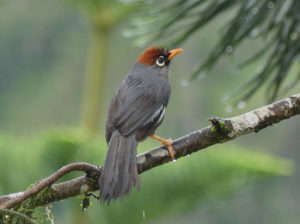
Fraser’s Hill is a fantastic birding location with a cooler climate than the lowlands and lots of exciting birds. With comfortable accommodation on-site travel is minimal as we enjoy birding around the network of quite roads that make up this old colonial hill station. In the hotel grounds bird feeders attract the incredible Fire-tufted Barbet, an amazing bird to see at close-quarters, feeding on a bird table! Other species that come down to the gardens include parties of Long-tailed Sibias and Malayan Laughingthrushes but being surrounded by forest means that we don’t need to go far to see birds. Feeding flocks near here can include beautiful Silver-eared Mesias, Black-eared Shrike-babblers and Blue Nuthatches, all superb birds.
Local birders have set up a number of feeding stations at various points around the mountain, all of which give us a great opportunity to see some very shy birds. Rufous-browed Flycatcher often comes down to take food as well as the normally skulking White-tailed Robin and cute little Pygmy Cupwing. One of the joys of these stakeouts is being able to watch birds at close-quarters and see their intricate plumage in detail.
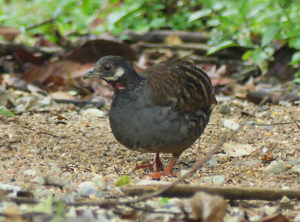
Even species such as Malayan Partridge often comes to feed at these stakeouts while boisterous Chestnut-capped Laughingthrushes seem to turn up everywhere. Other species we might see at these stakeouts are Buff-breasted Babbler, Streaked Wren Babbler and Mountain Fulvetta.
Birding along the road should turn up plenty of good birds including Black-and-crimson Oriole, the much sought-after Long-tailed Broadbill, Silver-breasted Broadbill, stunning Red-headed Trogon, colourful Black-browed Barbet, White-throated Fantail, superb Sultan Tit, Blyth’s Shrike-babbler, Golden Babbler and the delightful little Chestnut-crowned Warbler. This array of species is just a sample of what we can see here and illustrates why we have three full days here to enjoy to the full the birding here. Other specialities include the very shy Malayan Whistlingthrush which can sometimes be seen just after first light, Chestnut-crowned Forktail in small rushing streams, the sordidor subspecies of Blue-winged Minla and the musical Black Laughingthrush which can be amazingly skulking.
These days there are two roads on Fraser’s Hill, one for going up and one for going down which gives us plenty of opportunity to drive a loop to look for birds which inhabit slightly lower altitudes including White-crowned Hornbill, Bamboo Woodpecker and Red-throated Barbet. Quite simply this is one of the most pleasant birding sites in the whole of Southeast Asia given its diversity and abundance of species combined with on-site, comfortable accommodation.
Day 7, Krau Forest Reserve – Taman Negara – 12th September 2024

It will be hard to pull ourselves away from Fraser’s Hill but we need to leave in the very early morning to head to the lowlands at Krau Forest Reserve. On arrival we usually do some birding in the forest patches and farmland where we can find good birds that include Black Magpie, Black-and-red Broadbill and even Black Hornbill and Wreathed Hornbill. Into the forest itself there is a hide/blind we can visit to get close up views of species such as Ferruginous Babbler, Black-capped Babbler, Hairy-backed Bulbul, Short-tailed Babbler and perhaps even a Pitta! The forest along the track here is rich in species with cute little Black-thighed Falconets perched up high as well as Whiskered Treeswift. Inside the forest interior we will look for colourful Banded Broadbill and Scarlet-rumped Trogon with species such as Chestnut-winged and Rufous-crowned Babblers along the way. Here we have our first chances for Malaysian Rail Babbler and Garnet Pitta if we are lucky. As it gets hot we will break for lunch before continuing on our journey.
The journey to Taman Negara takes a few hours but we should reach the area early enough to visit areas of secondary forest close to the national park. Here we can look for Black-throated Babbler, a bird that is much smarter than field guides imply, as well as Black-and-yellow Broadbill, a species that looks like a cartoon character. These forest patches are surprisingly rich in birds with species such as Crested Jay present, Blue-crowned Hanging Parrot, Spectacled Spiderhunter as well as Blue-throated Bee-eaters. We will bird around here until it is time to cross the river to our accommodation within Taman Negara National Park itself.
Days 8-10, Taman Negara – 13th-15th September 2024
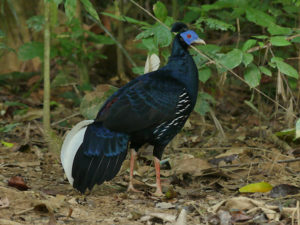
Taman Negara is one of the highest quality areas of lowland forest habitat remaining in the whole of Southeast Asia. With a good network of trails and access to many area by boat we are able to cover many areas of the forest and three full days gives us a good amount of time to find as many of the much-desired birds that are here as possible. A very comfortable eco lodge serves as a great base for us here and even birding outside our rooms can turn up exciting species such as Malaysian Eared Nightjar, Crested Fireback and Black Magpie. Fruiting trees in this area can also attract Puff-backed Bulbul, Scaly-breasted Broadbill, Thick-billed Green Pigeon, Little Green Pigeon and sometimes even Jambu Fruit Dove.
Birding along the trails is certainly not easy but with patience and the help of expert guides the potential rewards are great. We will need to be determined and persistent to see the best birds. Species such as Malayan Banded Pitta lurk on the forest floor and this is one of our best chances to see the stunning Garnet Pitta as it calls from a low perch. These birds are really fantastic and hopefully we can secure the sort of views that will live long in the memory.

In the mid-storey we hope to locate amazing, colourful birds such as Rufous-collared Kingfisher, Scarlet-rumped Trogon, Orange-backed Woodpecker, superb Green Broadbill and Red-naped Trogon. These birds are always fairly shy but with time and patience we have the best chance of seeing a high proportion of them. One of the most desired species on this trip will be Malaysian Rail Babbler and along the trails we usually encounter a few of these incredibly strange birds. We will have to be patient and very quiet while we lure this species in to get the best views.
Taman Negara protects some of the oldest rainforest in the world and as such there are a lot of huge trees with massive canopies. These are the trees that are favoured by hole-nesting Hornbills. Rhinoceros Hornbill is one of the most impressive species of the forest here but it can be surprisingly challenging to spot in the treetops. Helmeted Hornbill is an incredibly bizarre species, reduced in numbers across its range but we have a good chance of finding this amazing bird. Bushy-crested Hornbill can be fairly abundant and we may also come across Black Hornbill or Wreathed Hornbill here if we did not see them elsewhere.

Along the river we expect to see musical Straw-headed Bulbul in one of its final retreats, Stork-billed Kingfisher is fairly common while in the fringing trees Raffles’s Malkoha, Black-bellied Malkoha and the incredible Black-and-red Broadbill can usually be seen. While walking along the trails along the rivers if we are very lucky there could be an encounter with Great Argus while species such as Cinereous Bulbul, Gold-whiskered Barbet, Crimson-winged Woodpecker, Ferruginous Babbler, Yellow-crowned Barbet, Finsch’s Bulbul and Maroon Woodpecker are more expected. Open areas give us the chance of spotting perched birds including Black-thighed Falconet, Long-tailed Parakeet, Common Hill Myna and gives us a view of the largest trees favoured by large woodpeckers including both Great Slaty Woodpecker and White-bellied Woodpecker.
This exciting array of birds is far from exhaustive and there may be a few surprises along the way. With our time here we will focus on the key species in the mornings and late afternoons while taking after lunch breaks in our cool rooms to ensure that we make the most of the best birding times of the day.
Day 11, Taman Negara – Bukit Tinggi – 16th September 2024
We have time to have a final look for any key species that have not already been seen or perhaps we will leave early to visit another site that may give us a better opportunity. If we have struggled to see Malaysian Rail Babbler then we have another site that we can visit for this. We will decide exactly what we do throughout this day according to where we think the best chances of success lie. On our way to Bukit Tinggi we can make a few stops to pick up a bird or two along the way, perhaps at a rocky outcrop for Blue Whistlingthrush and Dusky Crag Martin. There are places where we can see the attractive Rufous-bellied Swallow too.
Day 12, Bukit Tinggi – Kuala Lumpur – 17th September 2024
Spending most of the day at Bukit Tinggi will allow us to target some specific birds of these highlands. The key reason for visiting is to attend a stake out which, over the last few years, has proven a draw for the seldom-seen Mountain Peacock Pheasant. This is a rare chance to find this bird so we will make sure we are in place at the stakeout in plenty of time. There may be other species that also arrive, such as Buff-breasted Babbler and White-rumped Shama, but after we have enjoyed the main event we will do some birding around the botanical gardens here. We might find Cinereous Bulbul or the attractive Scaly-breasted Bulbul feeding on seeding or flowering trees. Stunning Sultan Tit is another great bird that can be found here and there is another opportunity to see Black-browed Barbet if we did not connect with it at Fraser’s Hill. Olive-backed Woodpecker is another rare bird that can sometimes be found at this location too and we will also attempt to locate Pale Blue Flycatcher. Birding here up to and a little after lunch should provide a nice ending to our Peninsula Malaysia birding tour, with the opportunity to see some really scarce species and add some birds to our list that we might have failed to connect with earlier in the trip.
Day 13, Departure – 18th September 2024
You will be taken to the airport by the hotel shuttle bus at a time convenient to you according to the timetable to conclude this Peninsula Malaysia Birding Tour.
The following is a list of key bird species that we have a high chance of finding based on the experience of previous visits. This is not an exhaustive list of target birds but they are some of the regional highlights that we will put effort into finding and birds that we think are highly memorable and/or regional specialities. Equally we cannot guarantee that all of these Malaysian birds will be seen but we do expect to locate a high proportion of them. After all many of these are shy forest birds and not inhabitants of a zoo.
- Malayan Partridge – Arborophila campbelli
- Mountain Peacock Pheasant – Polyplectron inopinatum
- (Malayan) Crested Fireback – Lophura ignita (rufa)
- Whiskered Treeswift – Hemiprocne coronata
- Lesser Adjutant – Leptoptilos javanicus
- Oriental Pratincole – Glareola maldivarum
- Scarlet-rumped Trogon – Harpactes duvaucelii
- Red-headed Trogon – Harpactes erythrocephalus
- Red-naped Trogon – Harpactes kasumba
- White-crowned Hornbill – Berenicornis comatus
- Helmeted Hornbill – Rhinoplax vigil
- Rhinoceros Hornbill – Buceros rhinoceros
- Black Hornbill – Anthracoceros malayensis
- Red-bearded Bee-eater – Nyctyornis amictus
- Banded Kingfisher – Lacedo pulchella
- Rufous-collared Kingfisher – Actenoides concretus
- Fire-tufted Barbet – Psilopogon pyrolophus
- Yellow-crowned Barbet – Psilopogon henrici
- Black-browed Barbet – Psilopogon oorti
- Maroon Woodpecker – Blythipicus rubiginosus
- Orange-backed Woodpecker – Chrysocolaptes validus
- Olive-backed Woodpecker – Dinopium rafflesii
- Great Slaty Woodpecker – Mulleripicus pulverulentus
- White-bellied Woodpecker – Dryocopus javensis
- Sunda Pygmy Woodpecker – Picoides moluccensis
- Black-thighed Falconet – Microhierax fringilarius
- Long-tailed Parakeet – Psittacula longicauda
- Garnet Pitta – Erythropitta granatina
- Malayan Banded Pitta – Hydrornis irena
- Mangrove Pitta – Pitta megarhyncha
- Long-tailed Broadbill – Psarisomus dalhousiae
- Dusky Broadbill – Corydon sumatranus
- Black-and-red Broadbill – Cymbirhynchus macrorhynchos
- Green Broadbill – Calyptomena viridis
- Black-and-crimson Oriole – Oriolus consangineus
- Crested Jay – Platylophus galericulatus
- Rail Babbler – Eupetes macrocerus
- Pygmy Cupwing – Pnoepyga pusilla
- Straw-headed Bulbul – Pycnonotus zeylanicus
- Scaly-breasted Bulbul – Pycnonotus squamatus
- (Malayan) Streaked Wren Babbler – Turdinus brevicaudatus (leucostictus)
- Chestnut-capped Laughingthrush – Garrulax mitratus
- Black Laughingthrush – Garrulax lugubris
- Malayan Laughingthrush – Trochalopteron peninsulae
- Silver-eared Mesia – Leiothrix argentauris
- Blue-winged Minla – Minla cyanouroptera (cyanouroptera)
- Blue Nuthatch – Sitta azurea
- Rufous-browed Flycatcher – Anthipes solitaris
- Mangrove Blue Flycatcher – Cyornis rufigastra
- (Malayan) Lesser Shortwing – Brachypteryx wrayi (leucophris)
- White-tailed Blue Robin – Myiomela leucura
- Chestnut-naped Forktail – Enicurus ruficapillus
- White-crowned Forktail – Enicurus leschenaulti
- Malayan Whistlingthrush – Myophonus robinsoni
- Long-billed Spiderhunter – Arachnothera robusta
- Spectacled Spiderhunter – Arachnothera flavigaster
The map of Peninsula Malaysia below shows the main locations visited on this birding tour.
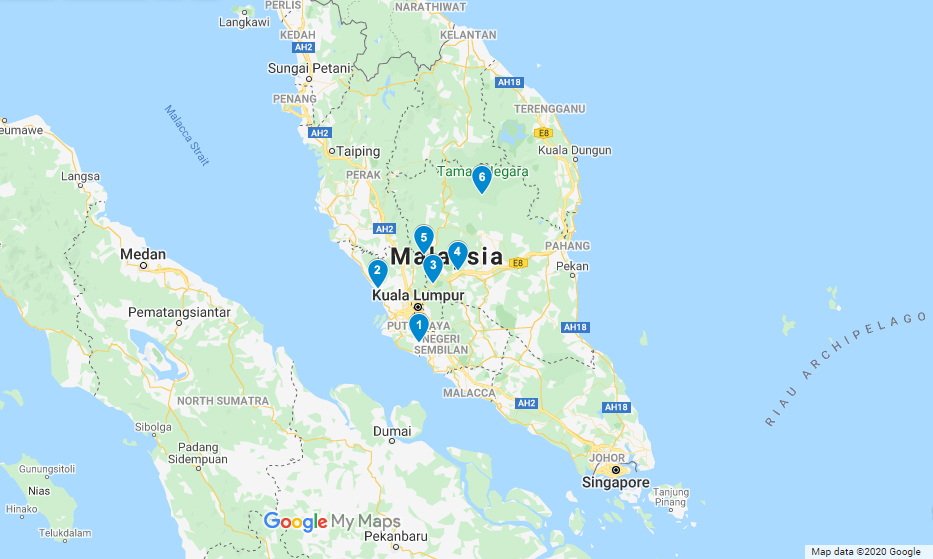
1. Kuala Lumpur Airport
5. Fraser’s Hill
2. Kuala Selangor
6. Taman Negara National Park
3. Bukit Tinggi
4. Krau Forest Reserve
The following is a selection of birds photographed in Peninsula Malaysia at the sites that we will visit on this tour.
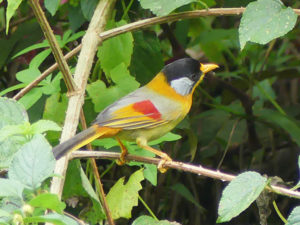
Silver-eared Mesia 
Mountain Peacock Pheasant 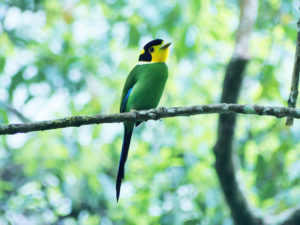
Long-tailed Broadbill 
Long-tailed Sibia 
Large Frogmouth 
Fire-tufted Barbet 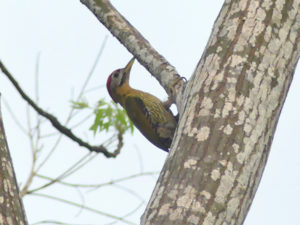
Laced Woodpecker 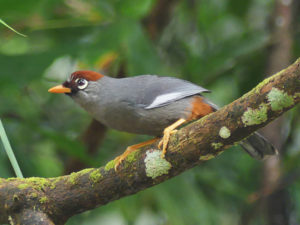
Chestnut-capped Laughingthrush 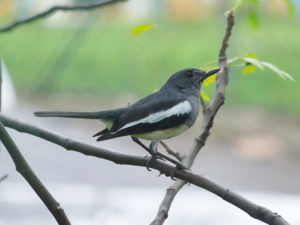
Oriental Magpie Robin 
Garnet Pitta 
Rufous-browed Flycatcher 
Sooty Barbet
All above photographs copyright Nick Upton/Calidris Birding Tours.
Tour Details
Tour Cost: £3950 per person
Single supplement: £660
Included in the tour cost: All transport including airport transfers, all meals, accommodation (based on two people sharing a room) within Malaysia, boat trips, bottled drinking water, national park entry fees, services of English-speaking birding guide and Calidris Birding Tours guide.
Not included in the tour cost: International flights, travel insurance, visa (most nationalities get 30-day visa-free entry), camera fee at Taman Negara (5 Ringgit), alcoholic and soft drinks, tips, excess baggage fees, laundry and any other items of a personal nature.
Accommodation: All accommodation on this tour is of a good standard. All rooms have en-suite toilet and showers as well as air-conditioning. Hotels and guest houses are all the best balance of proximity to the birding sites with quality and convenience. Wifi is available at all locations.
Physical effort: Mostly this is an easy trip, physically. At most locations we walk on quiet roads and tracks on level ground, a short distance from our vehicle. At Taman Negara we go on longer walks along forest trails. There is no uphill hiking involved but the trails are a little undulating and the humidity is high so participants need to be fit enough to be able to deal with these conditions for several hours at a time. Participants also need to be mobile enough to get in and out of river boats that sit low in the water and moor at the riverside. Afternoon breaks in comfortable accommodation are designed to give everyone sufficient time to rest and be fresh for birding at the key times of the day.
Weather: The weather will be quite hot and humid throughout in the lowlands while at Fraser’s Hill and Bukit Tinggi the climate is usually far cooler. It is expected to be largely dry but in this region there can be short, sharp rainstorms at any time.
Food: Most of the places we stay provide breakfast buffets that contain a wide range of foods. Lunch and evening meals usually consist of a typical selection of stir-fried Asian dishes, usually of Chinese influence. At Taman Negara there is a wide variety of cuisines available in the form of a buffet. The wide range of food that is available means that it is easy to cater to any particular eating preference or allergy. Please contact us to discuss any particular allergies or eating requirements so that we can ensure that we can cater for them.


Tour Leaders

Lee Collins
Lee is a lifelong birder who specializes in local patch birding at Dawlish Warren, UK, where he has found many national rarities. Having traveled in most continents he is a highly-experienced birder and his attention to detail, honed through ring-reading, is highly valued. Lee’s good humour and people skills are as important to us as his expertise in birding.

Lee Kok Chung
Lee has been an outdoor enthusiast his whole life and a professional bird guide since 2003. Lee has extensive birding experience in a wide range of Asian countries and is one of the most proficient and respected bird guides in Malaysia/Borneo. Lee’s organisational skills and professionalism are invaluable in the assured success of the tours he leads for us.
While we make every effort to adhere to the advertised itinerary for this Peninsula Malaysia birding tour, we reserve the right to make changes in the case of unforeseen circumstances that are beyond our control. These include problems with accessibility, national park closures, unseasonal weather events or any other reason that may demand a change of itinerary.
Recommended Field Guides
 Birds of Malaysia
Birds of Malaysia
Published in 2020 this is both the most complete and up to date field guide dealing with the birds of Malaysia. Covering Peninsula Malaysia as well as the Bornean states of Sabah and Sarawak this ield guide is well laid out and contains those all important range maps that some other publications do not. What we like about this book, and others in this series by Lynx Edicions, is how it is relevant to all taxonomies which makes our job easier when compiling the checklist!
Birders booking this tour with us will receive a 10% discount code when buying this field guide directly from the publisher.
Read our full review of the book here – Birds of Malaysia.
Related Blog Posts
- Morning Birding at Kuala Selangor – posted by Nick Upton 08/05/18
- Taman Negara – posted by Nick Upton 25/03/18
- Bukit Nanas, Kuala Lumpur – posted by Nick Upton 13/03/18
Terms and conditions: Please read full Calidris Birding Tours terms and conditions which apply to this Peninsula Malaysia Birding Tour.

